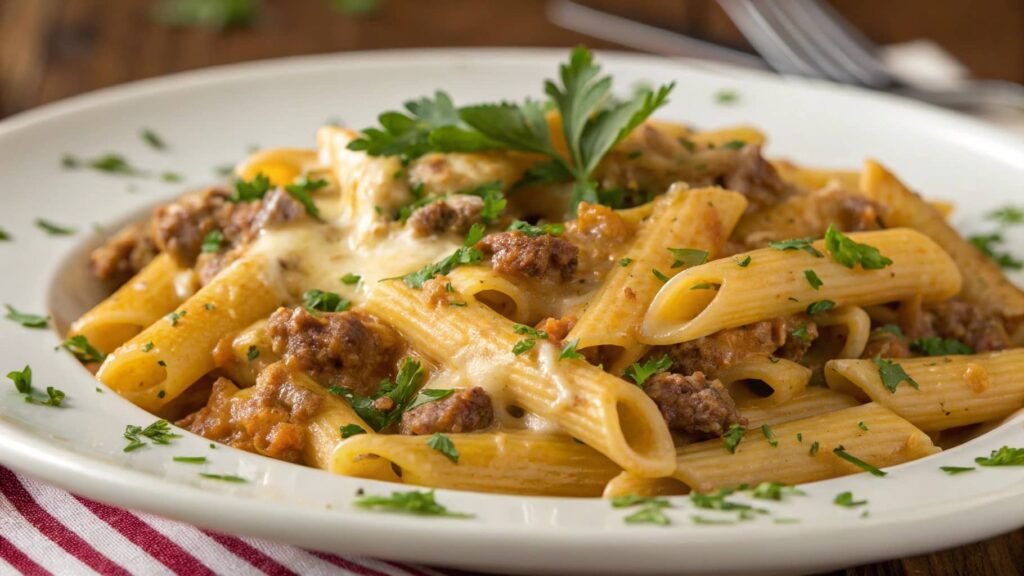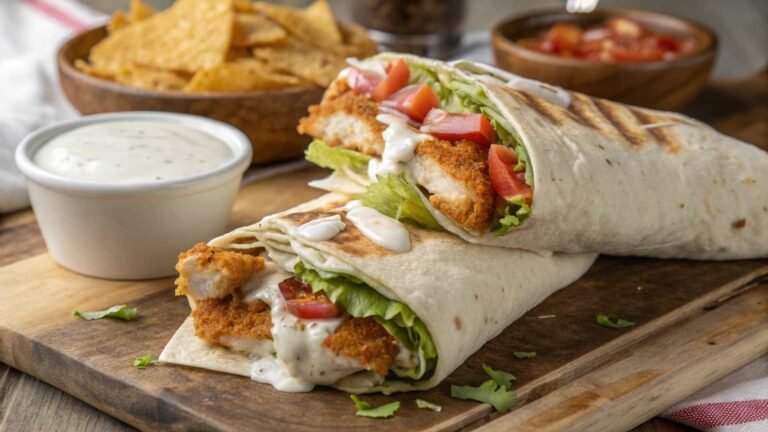Look, I’ve been cooking tilapia for years, and I’ve learned that sometimes the simplest methods yield the most delicious results. Pan-Seared Tilapia is my go, to technique when I want a quick, healthy dinner with minimal fuss but maximum flavor. If you’ve ever ended up with soggy, bland, or overcooked fish, this guide is for you.
So grab your favorite pan, and I’ll walk you through exactly how to get restaurant-quality tilapia at home – crispy on the outside, tender and flaky on the inside, and packed with flavor.
Table of Contents
Understanding Tilapia: Types and Flavor
What is Tilapia?
Tilapia is basically the chicken breast of the fish world – it’s affordable, widely available, and has a mild flavor that even people who claim they “don’t like fish” often enjoy. It’s low in fat, high in protein, and incredibly versatile in the kitchen.
I remember the first time I cooked tilapia – I was a college student on a budget, intimidated by seafood but wanting to eat healthier. Tilapia was my gateway fish, and I’ve been cooking it regularly ever since.
Expanding your seafood repertoire? Our Ultimate Fish Food Recipe Guide features innovative preparations for every skill level and occasion, perfect for when you’re ready to dive deeper into the world of homemade seafood cuisine.
Types of Tilapia
You’ll typically find a few different varieties at the store – Nile, Blue, and Mozambique tilapia are the most common. Honestly? For the average home cook, the differences are subtle enough that you don’t need to stress over which type you’re buying. I’ve cooked them all and they all work beautifully with this method.
Choosing Fresh Tilapia
Here’s what I look for when buying tilapia:
- The fillets should be firm and springy when touched (not mushy)
- The color should be pinkish-white to white, with no discoloration
- There should be NO fishy smell – fresh tilapia smells clean, maybe slightly sweet
If you can’t find good fresh tilapia, don’t hesitate to go with frozen. Often, frozen fish is flash-frozen right after catching, which can make it fresher than the “fresh” fish that’s been sitting in the case for days.
Have leftover tilapia? Transform it into mouthwatering Lake Trout Fish Cakes – they’re perfect for next-day lunches and just as impressive as the original dish!
Pan-Searing Basics: Techniques and Tools
The Right Pan
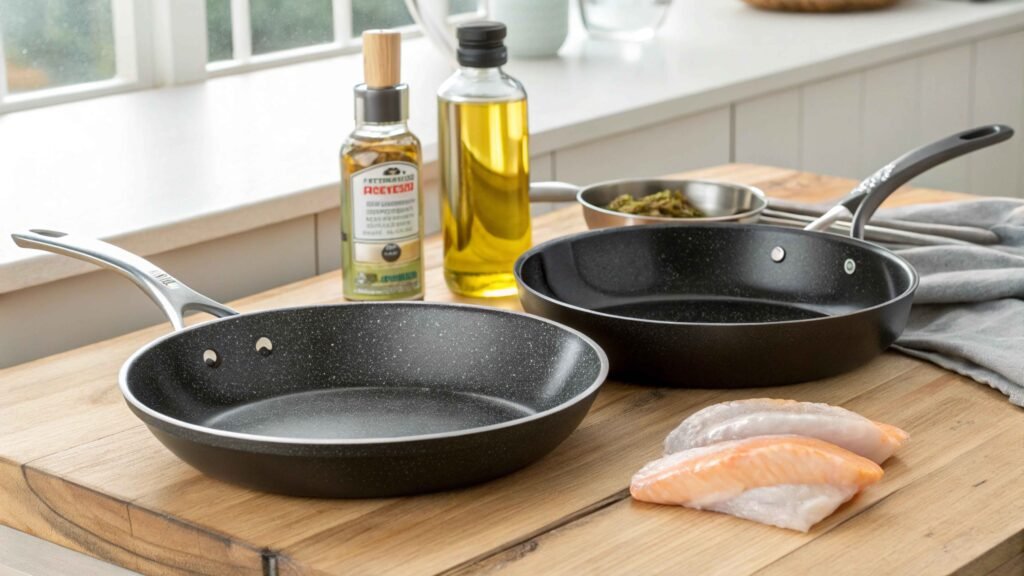
Use cast iron or heavy stainless steel pans for perfect searing. They retain heat evenly, creating crispy exteriors. Avoid thin pans that cause hot spots and sticking.
Oil Choice
Use high smoke point oils (avocado, canola, vegetable) – about 1 tablespoon. Heat until shimmering but not smoking.
Searing Technique
Place tilapia in hot pan and don’t disturb for 3 minutes. Flip once edges turn opaque and bottom is golden. Cook another 2-3 minutes. If it sticks when flipping, it needs more time to release naturally.
Essential Ingredients: Simple is Best
Key Ingredients for Pan-Seared Tilapia
You don’t need a ton of fancy ingredients for amazing tilapia. In fact, simple is often better. Here’s my basic formula:
| Ingredients | Quantity | Note |
|---|---|---|
| Tilapia Fillets | 2 (6-ounce) fillets | The fresher the better! |
| Oil | 1 tablespoon | Avocado oil is my preference, but any high-smoke-point oil works |
| Salt | To taste | I prefer kosher salt for its texture |
| Pepper | To taste | Freshly ground tastes noticeably better than pre-ground |
Optional Herbs and Spices
While basic salt and pepper work wonders, sometimes I like to add a little extra personality to my tilapia. Some of my favorite additions include:
- Garlic powder (not garlic salt) – adds depth without overwhelming
- Paprika – brings a subtle warmth and beautiful color
- Lemon pepper – brightens the flavor profile
- Dried dill – a classic fish companion
- Onion powder – adds sweetness and savory notes
Start with small amounts – maybe 1/4 teaspoon of each for two fillets. You can always adjust to your taste preferences on your next batch!
Want to elevate your tilapia with authentic Southern flavor? Try substituting the spice mixture with our homemade Hillbilly Fish Fry Seasoning for a crispy, perfectly seasoned crust that’ll transport you straight to a lakeside cookout.
Preparing the Tilapia: Simple Steps
Patting Tilapia Dry
This step might seem trivial, but it’s actually crucial. Take a few paper towels and gently but thoroughly pat your tilapia fillets dry on both sides.
Why? Physics! Water and hot oil are enemies. Any excess moisture on your fish will create steam, preventing proper searing and potentially causing dangerous oil splatters. Plus, moisture is the enemy of crispiness – you want that golden crust, right?
Seasoning the Fish
Once the fillets are dry, season them immediately before cooking (if you salt too far in advance, it can draw out too much moisture).
I like to sprinkle salt and pepper evenly over both sides of the fillet, using my fingers to ensure even distribution. If you’re using additional spices, add them now too.
Don’t be shy with seasoning, but remember that tilapia’s delicate flavor can be easily overwhelmed. Better to start lighter and adjust next time if needed.
Why Dry Fish Searing is Important
I mentioned this earlier, but it’s worth repeating: dry fish = crispy sear. Wet fish = steamed fish. They’re completely different experiences.
Think about it – when you want crispy chicken skin or a beautiful crust on a steak, you always start with a dry surface. Fish deserves the same treatment!
Cooking the Tilapia: Searing to Perfection
Cooking Time for Tilapia
Tilapia cooks quickly, which is another reason it’s perfect for weeknight dinners. The exact time depends on the thickness of your fillets:
- For thin fillets (about 1/2 inch): 2-3 minutes per side
- For thicker fillets (3/4 inch or more): 3-4 minutes per side
Remember, these are guidelines. Your actual cooking time might vary based on your stove’s heat output and the temperature of the fish when it goes into the pan.
Adjusting Cooking Time
Everyone’s stove is different! Gas stoves tend to get hotter than electric, and even among similar stoves, there can be significant variations in heat output.
Pay attention to visual cues: Is your fish browning too quickly? Turn down the heat a bit. Not getting any color after 2 minutes? Your pan probably wasn’t hot enough to begin with.
After you’ve cooked tilapia a few times on your stove, you’ll develop an intuitive sense of timing.
Avoiding Overcooking
Overcooked fish is dry, tough, and frankly, a waste of good tilapia. Here are my strategies to prevent it:
- Set a timer
- Look for the “opaque edge creep”
- Use the touch test – properly cooked fish feels firm but still has a slight give when gently pressed
- Remove the fish from the pan slightly before you think it’s done
Serving Suggestions: Sides and Sauces
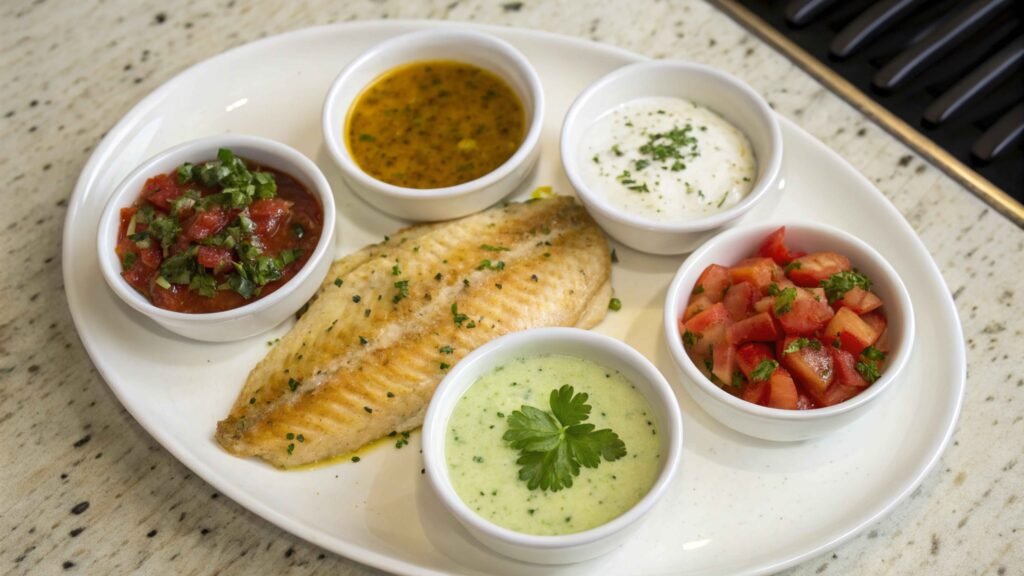
Side Dish Ideas
Tilapia pairs beautifully with so many sides. Some of my favorite combinations:
- Fluffy white rice with a simple garden salad – let the fish be the star
- Roasted asparagus and garlic mashed potatoes – elegant but easy
- Sautéed spinach with pine nuts and a wild rice pilaf – for something a bit fancier
- Crisp green beans and a crusty piece of bread – perfect for mopping up pan juices
The beauty of tilapia’s mild flavor is that it rarely clashes with side dishes, making it incredibly versatile for meal planning.
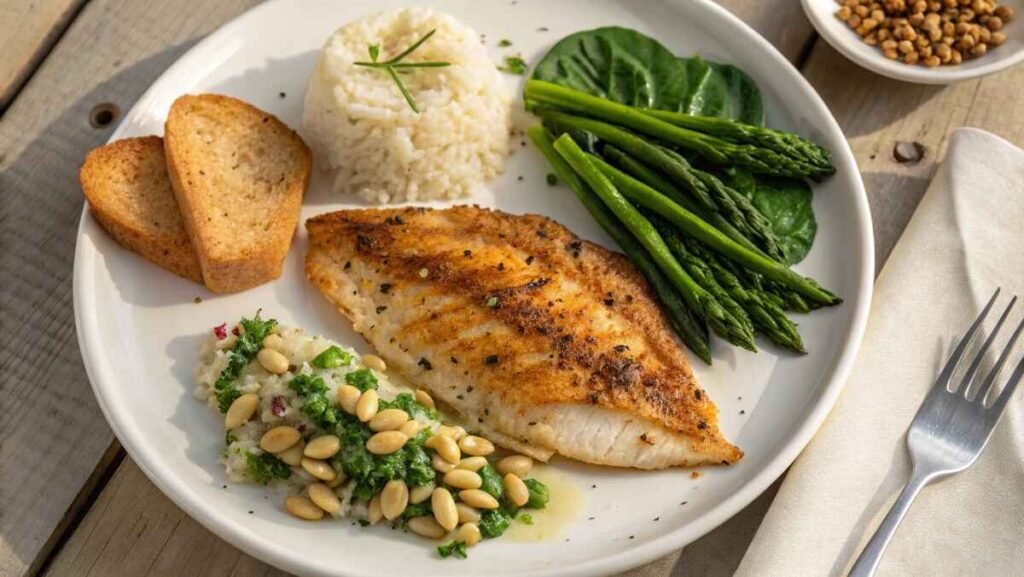
Sauce Suggestions
While perfectly cooked tilapia needs no sauce, sometimes I like to add a little something extra. Here are a few quick options:
- Classic lemon-butter: Melt 2 tablespoons of butter in a small pan, add the juice of half a lemon, a pinch of salt, and some freshly ground pepper. Maybe add some minced parsley if you’re feeling fancy.
- Garlic-herb drizzle: Mix 3 tablespoons olive oil with 1 minced garlic clove, 1 tablespoon of mixed fresh herbs (parsley, dill, chives, whatever you’ve got), and a squeeze of lemon juice.
- Simple salsa: Dice tomato, red onion, jalapeño, and cilantro, then mix with lime juice and salt for a fresh, vibrant topping.
- Greek-inspired: Mix Greek yogurt with cucumber, dill, lemon juice, and a bit of garlic for a cooling sauce that balances the warm fish perfectly.
Pro tip: If you make a sauce, serve it on the side or drizzle it on at the last moment. Pouring sauce over your beautifully crispy fish will sadly undo all your hard work in creating that perfect texture.
Flavor Variations: Beyond Basic
Herb and Spice Options
Once you’ve mastered the basic technique, the world of flavors is your oyster! Here are some of my favorite seasoning combinations:
- Mediterranean: dried oregano, lemon zest, and a touch of garlic powder
- Cajun-inspired: paprika, cayenne, garlic powder, onion powder, dried thyme
- Asian-inspired: ground ginger, garlic powder, and a touch of five-spice powder
- Mexican-inspired: ground cumin, mild chili powder, and a touch of oregano
Remember, with tilapia’s delicate flavor, you don’t need much – about 1/2 teaspoon total of mixed spices per fillet is plenty.
Marinade Magic
While not strictly necessary, a quick marinade can add tremendous flavor to tilapia. Just 15-30 minutes is enough (fish is more delicate than meat and absorbs flavors quickly).
A simple yet effective marinade I love:
- 2 tablespoons olive oil
- Juice of half a lemon
- 1 minced garlic clove
- Pinch of dried herbs (dill, parsley, or thyme)
- Salt and pepper to taste
Remember to pat the fish dry before cooking, even after marinating!
Sauce Sensations
Beyond the simple sauces I mentioned earlier, tilapia is a fantastic canvas for global flavors:
- Chimichurri: This Argentinian sauce of parsley, garlic, vinegar, and oil is zingy and fresh
- Mango salsa: Sweet, spicy, and tropical – perfect for summer dinners
- Piccata-style: Capers, lemon, butter, and white wine create a sophisticated pan sauce
- Coconut curry: Light coconut milk with a touch of curry paste makes an exotic sauce
Troubleshooting: Common Problems
Sticking Tilapia
Few things are more frustrating than fish that sticks to the pan and falls apart. Here’s how to prevent it:
- Make sure your fish is completely dry before seasoning
- Your pan must be hot enough before adding the fish
- Don’t try to flip the fish too early – it will release naturally when a crust has formed
- Make sure your pan is clean and well-maintained (especially important for stainless steel)
If you’re really struggling with sticking, try this trick: heat the pan first, then add the oil, let it heat for about 30 seconds, then add the fish. This slight modification in technique works wonders sometimes.
Overcooked Tilapia
We’ve covered this, but it bears repeating – overcooked fish is disappointing. If you consistently end up with dry tilapia:
- Your heat might be too high – try medium heat instead of medium-high
- Your timing might be off – set a timer and check earlier than you think necessary
- Your fillets might be thinner than average – adjust cooking time accordingly
- Try the “barely done” approach – take the fish off when it’s just about done, and let residual heat finish the cooking
Uneven Browning
Uneven browning usually indicates hot spots in your pan or uneven fillet thickness. Solutions:
- Invest in a heavier, higher-quality pan if possible
- On electric stoves, make sure your burner and pan size match well
- Try rotating the pan halfway through cooking to distribute heat more evenly
- For fillets with varying thickness, consider starting thicker portions first, or pressing down gently on thicker parts with a spatula (very gently!)
Frequently Asked Questions
What is the best pan to use for pan-searing tilapia?
A heavy cast iron skillet is my top choice, followed by a good stainless steel pan. Non-stick works too, especially if you’re a beginner, but you won’t get quite the same crispy crust. The key is even heat distribution – avoid thin, cheap pans that create hot spots.
What kind of oil should I use?
Use an oil with a high smoke point – avocado, canola, grapeseed, or vegetable oil all work well. Olive oil, especially extra virgin, isn’t ideal for high-heat cooking as it can break down and create bitter flavors.
How do I know when the tilapia is cooked?
Perfectly cooked tilapia should flake easily with a fork but still be moist. The flesh should be completely opaque – no translucent parts in the center. If you’re unsure, use a fork to gently peek inside the thickest part of the fillet.
What if my tilapia sticks to the pan?
Fish sticking usually means either your pan wasn’t hot enough before adding the fish, the fish wasn’t dry enough, or you tried to flip it too soon. The fish will naturally release from the pan when a proper crust has formed. Be patient!
What are some good side dishes to serve with pan-seared tilapia?
Tilapia pairs beautifully with nearly anything, but I especially love it with:
A simple rice pilaf and roasted vegetables
Garlic mashed potatoes and sautéed green beans
A crisp green salad with vinaigrette for a lighter meal
Couscous or quinoa for a healthier grain option
Crusty bread and a side of ratatouille for a Mediterranean vibe
The mild flavor of tilapia means it won’t compete with your sides, giving you endless possibilities.
Conclusion: Enjoy Your Delicious Tilapia!
Your Pan-Seared Tilapia
By now, you should feel confident in your ability to cook restaurant-quality tilapia at home. Remember the key points:
- Start with good quality, properly dried fish
- Use a heavy pan and the right oil
- Get your pan hot before adding the fish
- Be patient – don’t flip too early
- Cook just until done, not a minute longer
It might take a couple of tries to perfect your technique, but I promise it’s worth the effort. There’s something incredibly satisfying about serving a piece of fish with that perfect golden crust and tender, flaky interior.
Serving and Flavor
Don’t overthink your first few tilapia dinners – simple really is best. A wedge of lemon, a sprinkle of fresh herbs, and a side dish you already love are all you need. As you gain confidence, experiment with different seasoning blends and sauces to find your favorite combinations.
Print
Pan-Seared Tilapia: A Simple and Delicious Guide
This pan-seared tilapia recipe features perfectly crisp fish fillets with a golden crust, topped with a silky lemon butter sauce. Ready in just 20 minutes, it’s an elegant yet simple weeknight dinner that tastes restaurant-quality. The delicate fish develops a beautiful caramelized exterior while staying moist and flaky inside, complemented by a bright, rich sauce that enhances without overpowering its mild flavor.
- Total Time: 15 minutes
- Yield: 4 servings 1x
Ingredients
- 4 tilapia fillets (about 6 oz each), patted dry
- 1/2 teaspoon salt
- 1/4 teaspoon black pepper
- 1/4 teaspoon garlic powder
- 1/8 teaspoon paprika
- 2 tablespoons olive oil
- 3 tablespoons unsalted butter, divided
- 2 cloves garlic, minced
- Juice of 1 lemon (about 2 tablespoons)
- 1 tablespoon fresh parsley, chopped
- Lemon wedges for serving
Instructions
- Pat tilapia fillets completely dry with paper towels. This is crucial for achieving a good sear.
- In a small bowl, combine salt, pepper, garlic powder, and paprika. Season both sides of fish fillets evenly with the spice mixture.
- Heat olive oil in a large non-stick skillet over medium-high heat until shimmering.
- Carefully add tilapia fillets to the hot pan, ensuring not to overcrowd (cook in batches if needed).
- Cook for 3-4 minutes on the first side without moving, until golden brown and crisp.
- Gently flip the fillets and cook for another 2-3 minutes until the fish is opaque and flakes easily with a fork.
- Transfer fish to a warm plate and cover loosely with foil.
- Reduce heat to medium-low and add 2 tablespoons of butter to the same pan.
- Once butter is melted, add minced garlic and cook for 30 seconds until fragrant.
- Add lemon juice and stir, scraping up any browned bits from the pan.
- Cook for 1 minute, then stir in remaining 1 tablespoon of butter until melted and sauce is slightly thickened.
- Return fish to the pan, spoon sauce over fillets, and sprinkle with fresh parsley.
- Serve immediately with lemon wedges.
Notes
- For the best sear, ensure your fish is completely dry before seasoning and that your pan is properly heated.
- If tilapia fillets are very thin, reduce cooking time by about 1 minute per side.
- This recipe works well with other mild white fish like cod, sole, or flounder.
- For a dairy-free option, replace butter with additional olive oil or a plant-based butter alternative.
- Leftover fish can be stored in an airtight container in the refrigerator for up to 2 days.
- Prep Time: 5 minutes
- Cook Time: 10 minutes
- Category: Main Dish
- Method: Pan-Searing
- Cuisine: American
- Diet: Gluten Free
Nutrition
- Serving Size: 1 fillet with sauce
- Calories: 240
- Sugar: 0g
- Sodium: 380mg
- Fat: 15g
- Saturated Fat: 6g
- Unsaturated Fat: 8g
- Trans Fat: 0g
- Carbohydrates: 1g
- Fiber: 0g
- Protein: 26g
- Cholesterol: 85mg

